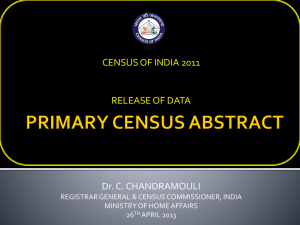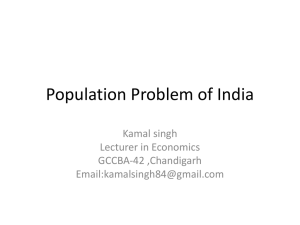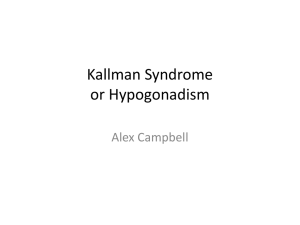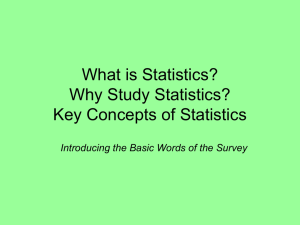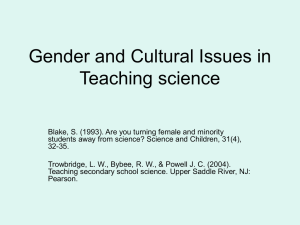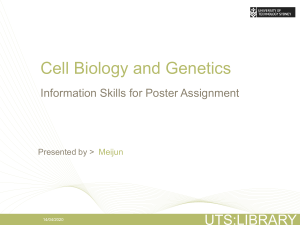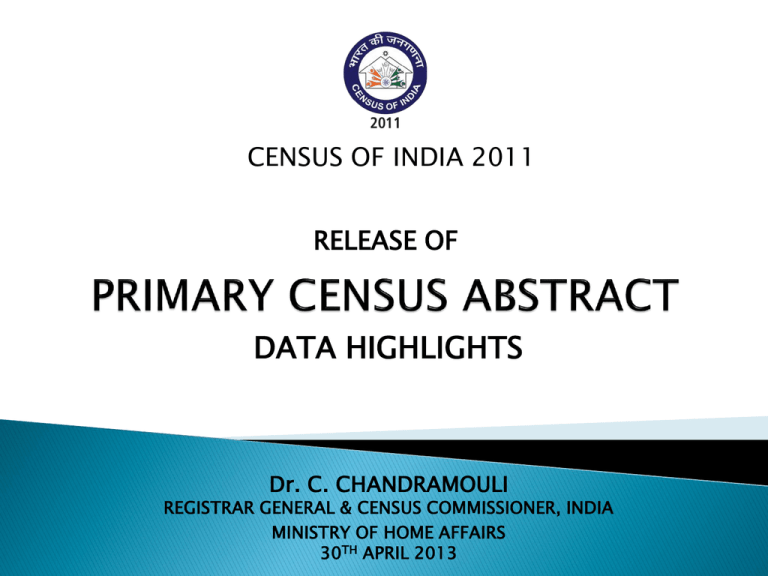
CENSUS OF INDIA 2011
RELEASE OF
DATA HIGHLIGHTS
Dr. C. CHANDRAMOULI
REGISTRAR GENERAL & CENSUS COMMISSIONER, INDIA
MINISTRY OF HOME AFFAIRS
30TH APRIL 2013
• This is the first set of final data from the Population
Enumeration exercise held in February 2011
• So far the data released from Census 2011 pertained
to Houselisting and Housing Census covering
• All Households
• SC & ST Households
• Female Headed Households
• Slum Households
• Population*
• Density
• Population (0-6)*
• Scheduled Castes Population
• Scheduled Tribes Population
• Number of Literates*
• Number of Workers (Total, Main, Marginal)
• Category of Economic Activity (Cultivators,
Agricultural Labourers, Household Industry
Workers, Other Workers)
• Non Workers
By Sex & Residence
* - Provisional data released earlier
DATA HIGHLIGHTS
Population of India
Census 2011
As on 0.00 Hrs. of 1st March, 2011
• Final Total Population of the country is
1,210,726,932* (or 1.21 billion)
• Provisional Population Total
1,210,193,422*
• Difference: + 533,510 persons (0.04%)
* Includes the estimated population of Mao Maram, Paomata and Purul subdivisions of Senapati district of Manipur.
In the remaining slides, the figures exclude the estimated population of Mao
Maram, Paomata and Purul sub-divisions of Senapati district of Manipur.
Decadal Change in Population
India : 2001-2011
• There has been an increase of 181.96 million
persons in absolute number of population in
India during 2001-11
• Increase among males:
90.97 million
• Increase among females:
90.99 million
• Growth Rate of females (18.3%) is higher than
males (17.1%)
Decadal Change in Population
India : 2001-2011
• Population of India grew by 17.7% during 200111, against 21.5% in the previous decade
• Among the major States, highest decadal growth
in population has been recorded in Bihar (25.4%)
• 14 States/UTs have recorded population growth
above 20%.
DECADAL
CHANGE IN
POPULATION
(IN %)
Population – Rural Urban Distribution
India : 1961-2011
• 833.5 million persons live in Rural areas as per Census
2011 - more than two-third of the total population
• 377.1 million persons live in urban areas.
Proportion of Urban Population
India : 1951-2011
• Urban proportion has gone up from 17.3% in 1951 to 31.2% in 2011.
• EAG states have lower urban proportion (21.1%) in comparison to non EAG states
(39.7% )
• Highest proportion of urban population is in NCT Delhi (97.5%)
• Top 5 States: Goa (62.2%), Mizoram (52.1%), Tamil Nadu (48.4%), Kerala (47.7%) &
Maharashtra (45.2%)
PROPORTION
OF URBAN
POPULATION
(IN %)
Density of Population
India : 2011
(Persons per sq. km.)
Density of Population , India
2001
2011
325
382
• Delhi (11,320) turns out to be the most densely inhabited
followed by Chandigarh (9,258), among all States/UTs, both in
2001 and 2011 Census.
• Among the major States, Bihar occupies the first position with a
density of 1106, surpassing West Bengal which occupied the first
position during 2001.
• The minimum population density works out in Arunachal Pradesh
(17) for both 2001 and 2011 Census.
DENSITY OF
POPULAITON
Child Population (0-6 years)
India : 2001, 2011
(in million)
2001
2011
Variation
(in %)
163.8
164.5
+0.4 %
Males
85.0
85.7
+0.8 %
Females
78.8
78.7
-0.1 %
Persons
• The Child Population (0-6) is almost
stationary - grown by only 0.4% in the
last decade.
• In 17 States/UTs the Child Population
has declined in 2011 compared to
2001.
PROPORTION
OF CHILD
POPULATION
(IN %)
Sex Composition of Child Population
(0-6) – India 2011
• The total number of children in India is 164.5 millions,
about 660 thousand more than the number recorded in
2001
• Male Child (0-6) population has increased whereas
Female Child population has decreased marginally
during 2001-11
• 8 States, viz. Jammu & Kashmir, Rajasthan, Uttar
Pradesh, Bihar, Jharkhand, Arunachal Pradesh, Mizoram,
Meghalaya have proportion of child population more
than 15 percent.
Sex Ratio of Population
India : 2001, 2011
Sex ratio is defined as the number of females per 1000
males in a population.
Residence
2001
2011
Change
Total
933
943
+10
Rural
946
949
+3
Urban
900
929
+29
SEX RATIO
States Ranked by Sex Ratio – 2011
(Major States – Population 10 million and above)
Top 5 States
Bottom 5 States
States
Sex Ratio
Kerala
1,084
States
Sex Ratio
Haryana
879
Tamil Nadu
996
Jammu & Kashmir
889
Andhra Pradesh
993
Punjab
895
Chhattisgarh
991
Uttar Pradesh
912
Odisha
979
Bihar
918
* Sex Ratio is defined as the number of females per 1000 males
Child Sex Ratio (0-6)
India : 2001, 2011
• The sex ratio in the age group 0-6 attempts to bring out
the recent changes in our society in its attitude and
outlook towards the girl child.
• Also an indicator of the likely future trends of sex ratio in
the population.
Residence
2001
2011
Change
Total
927
919
-8
Rural
934
923
-11
Urban
906
905
-1
CHILD
SEX RATIO
States Ranked by Child Sex Ratio (0-6)
2011 (Major States – Population 10 million and above)
Top 5 States
States
Bottom 5 States
Sex Ratio
(0-6 yrs)
States
Sex Ratio
(0-6 yrs)
Chhattisgarh
969
Haryana
834
Kerala
964
Punjab
846
Assam
962
Jammu & Kashmir
862
West Bengal
956
Rajasthan
888
Jharkhand and
Karnataka
948
Gujarat
890
* Child Sex Ratio (0-6) is defined as the number of females
per 1000 males in the age group 0-6 years.
Scheduled Caste (SC)
&
Scheduled Tribe (ST)
SCs/STs in India - 2011
• Scheduled Castes are notified in 31 States/UTs of
India and Scheduled Tribes in 30 States
• There are altogether 1,241 individual ethnic
groups, etc. notified as Scheduled Castes in
different States/UTs
• Number of individual ethnic groups, etc. notified
as Scheduled Tribes is 705
• There has been some changes in the List of
SCs/STs in States/ UTs during the last decade
Population of SCs
India : 2011
(in million)
2001
2011
Variation
(%)
166.6
201.4
+20.8 %
Males
86.1
103.5
+20.3 %
Females
80.5
97.9
+21.5 %
Persons
Population of STs
India : 2011
(in million)
Sex
2001
2011
Variation
(%)
Persons
84.3
104.3
+23.7 %
Males
42.6
52.4
+22.9 %
Females
41.7
51.9
+24.4 %
Proportion of SC/ST Population
India – 2001, 2011
(In %)
Proportion of SCs Proportion of STs
2001
2011
2001
2011
Total
16.2
16.6
8.2
8.6
Rural
17.9
18.5
10.4
11.3
Urban
11.8
12.6
2.4
2.8
PROPORTION
OF SCs
PROPORTION
OF STs
(In %)
Rest
Uttar Pradesh
15.0
20.5
Odisha
3.6
Punjab
4.4
Karnataka
West Bengal
5.2
10.7
Madhya Pradesh
5.6
Bihar
Rajasthan
6.1
8.2
Maharashtra
6.6
Andhra
Tamil Nadu
Pradesh
7.2
6.9
(In %)
Rest
Meghalaya
Assam
11.6
Madhya Pradesh
14.7
2.5
3.7
Karnataka
Maharashtra
4.1
10.1
West Bengal
5.1
Andhra Pradesh
Odisha
5.7
9.2
Chhattisgarh
7.5
Rajasthan
8.9
Jharkhand
8.3
Gujarat
8.6
States/UTs Ranked by Proportion of
SCs - 2011
Top 5 States/UTs
Bottom 5 States/UTs
Punjab
31.9%
Mizoram
0.1%
Himachal Pradesh
25.2%
Meghalaya
0.6%
West Bengal
23.5%
Goa
1.7%
Uttar Pradesh
20.7%
Dadra & Nagar
Haveli
1.8%
Haryana
20.2%
Daman & Diu
2.5%
States/UTs Ranked by Proportion of
STs - 2011
Top 5 States/UTs
Bottom 5 States/UTs
Lakshadweep
94.8%
Uttar Pradesh
0.6%
Mizoram
94.4%
Tamil Nadu
1.1%
Nagaland
86.5%
Bihar
1.3%
Meghalaya
86.1%
Kerala
1.5%
Arunachal Pradesh
68.8%
Uttarakhand
2.9%
Literates
&
Literacy Rates
Number of Literates
India : 2001, 2011
• A person (aged 7 and above) is considered literate, if he
or she can read and write, with understanding, in any
language.
(in millions)
Sex
2001
2011
Change
Persons
560.7
763.5
+202.8
Males
336.5
434.7
+98.2
Females
224.2
328.8
+104.6
Literacy Rate
India : 2001, 2011
(in %)
Difference
2001
2011
Persons
64.8
73.0
+8.2
Males
Females
75.3
53.7
80.9
64.6
+5.6
+10.9
(2011 – 2001)
• Largest increase: Dadra & Nagar Haveli by 18.6 points (from 57.6% to 76.2%),
Bihar by 14.8 points (from 47.0% to 61.8%), Tripura by 14.0 points (from
73.2% to 87.2%)
• Improvement in Female literacy is higher than males in all States/UTs, except
Mizoram (where it is same in both Males and Females) during the decade
2001-11.
Literacy Rate – Rural Urban Differential
India - 2001, 2011
• Gap between Literacy Rate in Urban and Rural areas is steadily
declining in every census. In Census 2011, the gap stands at
16.3 points
Gender Gap in Literacy Rate
India - 2001, 2011
• Gender gap in Literacy Rate is steadily declining in every
census. In Census 2011, the gap stands at 16.3 points
LITERACY
RATE AMONG
FEMALES
States/UTs Ranked by Literacy Rate
2011
(In %)
Top 5 States/UTs
States/UTs
Bottom 5 States/UTs
Literacy
Rate
States/UTs
Literacy
Rate
Kerala
94.0
Bihar
61.8
Lakshadweep
91.8
Arunachal Pradesh
65.4
Mizoram
91.3
Rajasthan
66.1
Goa
88.7
Jharkhand
66.4
Tripura
87.2
Andhra Pradesh
67.0
Workers,
Work Participation
Rate (WPR)
&
Categories of
Economic Activity
Definition of Work
(Economic Activity)- 2011
Worker:
A person who has participated in any economically
productive activity with or without compensation or
profit
Reference period: one year preceding the date of enumeration
Number of Workers by Residence
India : 2011
(in million)
Residence
Number of
Workers
Non-Workers
Work
Participation
Rate*
Total
481.7
728.8
39.8%
Rural
348.6
484.9
41.8%
Urban
133.1
243.9
35.3%
* Work Participation Rate is defined as the number of workers
per 100 population
Work Participation Rate
India : 2001, 2011
(In %)
Residence Sex
Total
2001
2011
Change
Persons
39.1
39.8
+0.7
Males
51.7
53.3
+1.6
Females
25.6
25.5
-0.1
WORK
PARTICIPATION
RATE (PERSONS)
WORK
PARTICIPATION
RATE (MALES)
WORK
PARTICIPATION
RATE (FEMALES)
States/UTs Ranked by WPR- 2011
(In %)
Top 5 States/UTs
States/UTs
Bottom 5 States/UTs
WPR
States/UTs
WPR
Himachal Pradesh
51.9
Lakshadweep
29.1
Sikkim
50.5
Uttar Pradesh
32.9
Daman & Diu
49.9
NCT of Delhi
33.3
Nagaland
49.2
Bihar
33.4
Chhattisgarh
47.7
Jammu & Kashmir
34.5
States/UTs Ranked by WPR
Females : 2011
(In %)
Top 5 States/UTs
States/UTs
Bottom 5 States/UTs
WPR(F)
States/UTs
WPR(F)
Himachal Pradesh
44.8
NCT of Delhi
10.6
Nagaland
44.7
Lakshadweep
11.0
Chhattisgarh
39.7
Punjab
13.9
Sikkim
39.6
Daman & Diu
14.9
Manipur
38.6
Chandigarh
16.0
Type of Workers- 2011
•
Main Worker: Persons who ‘worked’ for 6 months or more
during the reference year
•
Marginal Worker: Persons who ‘worked’ for less than 6
months.
• For the first time in Census 2011, the marginal
workers have been sub-divided in two categories,
namely, those worked for less than 3 months and
those who worked for 3 to 6 months
•
Non-Worker: Persons who did not ‘work’ at all during the
reference period. Includes students, persons engaged in
household duties, dependents, pensioners, beggars, etc.
Type of Workers
India : 2001, 2011
(in %)
Persons
Males
Females
Residence
Sex
2001
2011
Change
Main Workers
Persons
77.8
75.2
-2.6
Males
87.3
82.3
-5.0
Females
57.3
59.6
2.3
Marginal Workers Persons
22.2
24.8
2.6
Males
12.7
17.7
5.0
Females
42.7
40.4
-2.3
PROPORTION
OF MAIN
WORKERS
PROPORTION
OF MARGINAL
WORKERS
Decadal Change in Work Participation Rate
(WPR) States/UTs: 2001,2011
• The WPR in the country has recorded a marginal
increase from 39.1% in 2001 to 39.8% in 2011
• Majority of the States/ UTs have shown increase in
WPR between 2001-2011 ; Highest increase in
Nagaland (6.6 pp)
• In 9 States/UTs, WPR has declined; Mizoram (-8.2
pp), D & N Haveli, Haryana, Jammu & Kashmir,
Meghalaya, Punjab, Arunachal Pradesh, Gujarat, Bihar
(-0.3 pp)
Marginal Workers: 2011
(in millions)
Total Marginal
Workers
Marginal
Workers
(3-6 months)
Marginal
Workers
(less than 3
months)
119.3
97.1
22.2
Males
58.7
48.6
10.1
Females
60.6
48.5
12.1
Persons
100.0
81.4
18.6
Males
100.0
82.8
17.2
Females
100.0
80.0
20.0
Persons
Percentages
Category of Workers - India: 2011
(in
millions)
Total Workers
(in millions)
(Main + Marginal)
• Cultivators
118.7
(24.6%)
• Agricultural Labourers
144.3
(30.0%)
18.3
( 3.8%)
200.4
(41.6%)
• Household Industries Workers
• Other Workers
Total Workers
481.7
(100.0%)
PROPORTION
OF
CULTIVATORS
PROPORTION
OF
AGRICULTURAL
LABOURERS
PROPORTION
OF WORKERS IN
HOUSEHOLD
INDUSTRIES
PROPORTION
OF OTHER
WORKERS
Category of Workers
Change in Proportions - India: 2001 &2011
(in %)
Residence Category
2001
2011
Change
100.0
100.0
Cultivators
31.7
24.6
- 7.1
Ag. Labourers
26.5
30.0
+3.5
4.2
3.8
-0.4
37.6
41.6
+4.0
Workers (Main + Marginal)
All Areas
Total Workers
HHI Workers
Other Workers
• Agriculture sector: 54.6 % of Total Workers, decline by
3.6 percent points
Thank you
http://www.censusindia.gov.in

